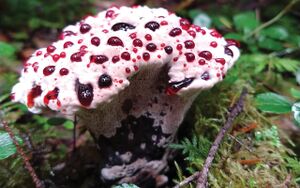Hydnellum peckii
Common names include Devil's Tooth, the Strawberry and Cream mushroom, and Bleeding Tooth fungus.
Located in forested, often mountainous, areas in North America, Europe, Iran, and South Korea, the Bleeding Tooth Fungus has a symbiotic relationship with the coniferous trees amongst whose roots it is located. The trees provide the fungus with access to a fixed source of carbon dioxide, while the fungus produces enzymes that convert amino acids and minerals found in the soil into forms that the host trees can better use. The fungi's presence is indicative of an old, species-rich forest, and scientists express concern when it disappears from an area, as seems to be happening in areas of Europe, where nitrogen deposits caused by pollution may be a problem.[1]
Along with it's medicinal properties, the H. peckii is valued by natural dyers, who dry it and use it alone to create a beige dye or combine it with mordants (substances, such as allum or iron, that cause a dye to set into fabric and other surfaces) to create blue-green hues.

| |
| Kingdom: | Fungi |
|---|---|
| Phylum: | Basidiomycota |
| Class: | Basidiomycetes |
| Order: | Thelephorales |
| Family: | Bankeraceae |
| Genus: | Hydnellum |
| Species: | H. peckii |
Habitat and Distribution
Commonly found in the Pacific Northwest of the North American continent, Hydnellum peckii is also distributed in other parts of North Korea and Europe. Recently, it has been reported in Korea, segments of the Middle East and Russia.[2]
The approximate global population as of 2020 was approximately 40,000 individuals. Population trend is improving, however they are reported to be extinct in the Netherlands and appreciably reduced in population in Germany. The United Kingdom sited them as a vulnerable species in 2004 and further demoted them to endangered in 2006.[1]

Is it Edible?
While not classified as poisonous, the Devil’s Tooth fungus is incredibility bitter and eating it is not recommended.[3]
Identification Guide[4]
Fruit Bodies
Characterized by a teeth-like hymenium, rather than gills or pores on the underside of the mushroom cap. These “teeth” cover the cap’s underside and are specialized structures used to produce spores. Fruit bodies grow in close proximity and often appear to merge together. They can reach a height of up to 10.5cm. Young specimens, lump-like in appearance, exude a striking, thick red fluid when they are moist.

Cap
The cap’s surface is convex to flattened, more or less uneven, and sometimes is found to have a slightly depressed region in the cap’s center. It is usually covered with “hairs” that give it a texture similar to velvet. As the fungus ages, these hairs are sloughed off, leaving the caps of mature individuals smooth. Its shape varies from somewhat round to irregular, and 4 to 10cm wide. As a result of confluence, the merging of who separate specimens due to their close growth proximity, cap width can reach a width of up to 20cm in diameter. Initially, the cap is whitish in color, but later turns slightly brownish with irregular dark-brown to nearly black blotches if it becomes bruised. In maturity, the surface is fibrous and tough, scaly and jagged, somewhat woody, and with grayish brown in the upper parts of the cap.

Spines
Spines are slender, cylindrical, and tapering. They are typically less than 5mm long and become shorter closer to the cap edge. They are crowded together, typically between three and five teeth per square millimeter. Color wise, they are initially pinkish white and as they age, they become a greyish brown.
Stem
The stem is thick, very short and often deformed in some capacity. It becomes bulbous where it penetrates the ground and roots may expand into the soil for several centimeters. Although it may reach up to 5cm in total length, only about 0.1 to 1cm appear above ground. The upper part of the stem is covered with the same teeth found on the underside of the cap, whereas the lower segments are hairy and often encased in debris from the forest floor.
Flesh
The flesh of the specimen is a pale, pinkish brown.
Odor
The odor of the fruit body has been previously described as “mild to disagreeable” or, as described in the original description by Howard James Banker, who discovered the species in 1912, similar to hickory nuts.
Spore Print
Brown in color.
Microscopic Features
The spores of Hydnellum peckii are brown, roughly spherical, with small nodules on their surface. They range in size from 4.0-5.3 um. They are inamyloid, meaning they do not absorb iodine when stained. The hyphae that form the cap are translucent, smooth, and thin-walled, with an average thickness of 3-4um. They have cellular compartments and clamp connections, forming an intricate tangle with a longitudinal tendency. The basidia, spore-bearing cells in the hymenium, are club-shaped, four-spored, and measure 35-40 by 4.7-6um. Collapsed hyphae can be revived with a weak solution of potassium hydroxide.
Medicinal Applications
Sap of the Devil’s Tooth mushroom contains a chemical compound call atromentin, a compound that has anticoagulant properties and is commonly used to help prevent blood clots from forming. The pigment producing compound found in several fungi species, atromenin also acts as a smooth muscle stimulant and has anibacterial and antineoplastic (anticancer) properties.[5]

References
- ↑ 1.0 1.1 1.2 "Hydnellum peckii", The Global Fungal Red List Initiative. (n.d.). Hydnellum peckii. Natalie Tan. Retrieved 3/30/2023
- ↑ Hydnellum peckii banker - devil's tooth, O'Reilly, P. (n.d.). Retrieved 3/30/2023.
- ↑ Real Mushrooms, 2022, March 4. Weird mushrooms: Profiling 9 of the world's strangest fungi. Retrieved 3/31/2023.
- ↑ Hydnellum peckii: The Ultimate Mushroom Guide, (n.d.). ultimate-mushroom.com. Retrieved 4/1/2023.
- ↑ Atromentin. (n.d.). . U.S. National Library of Medicine. Retrieved 4/1/2023.